The 16-day diet that will help you lose half a stone
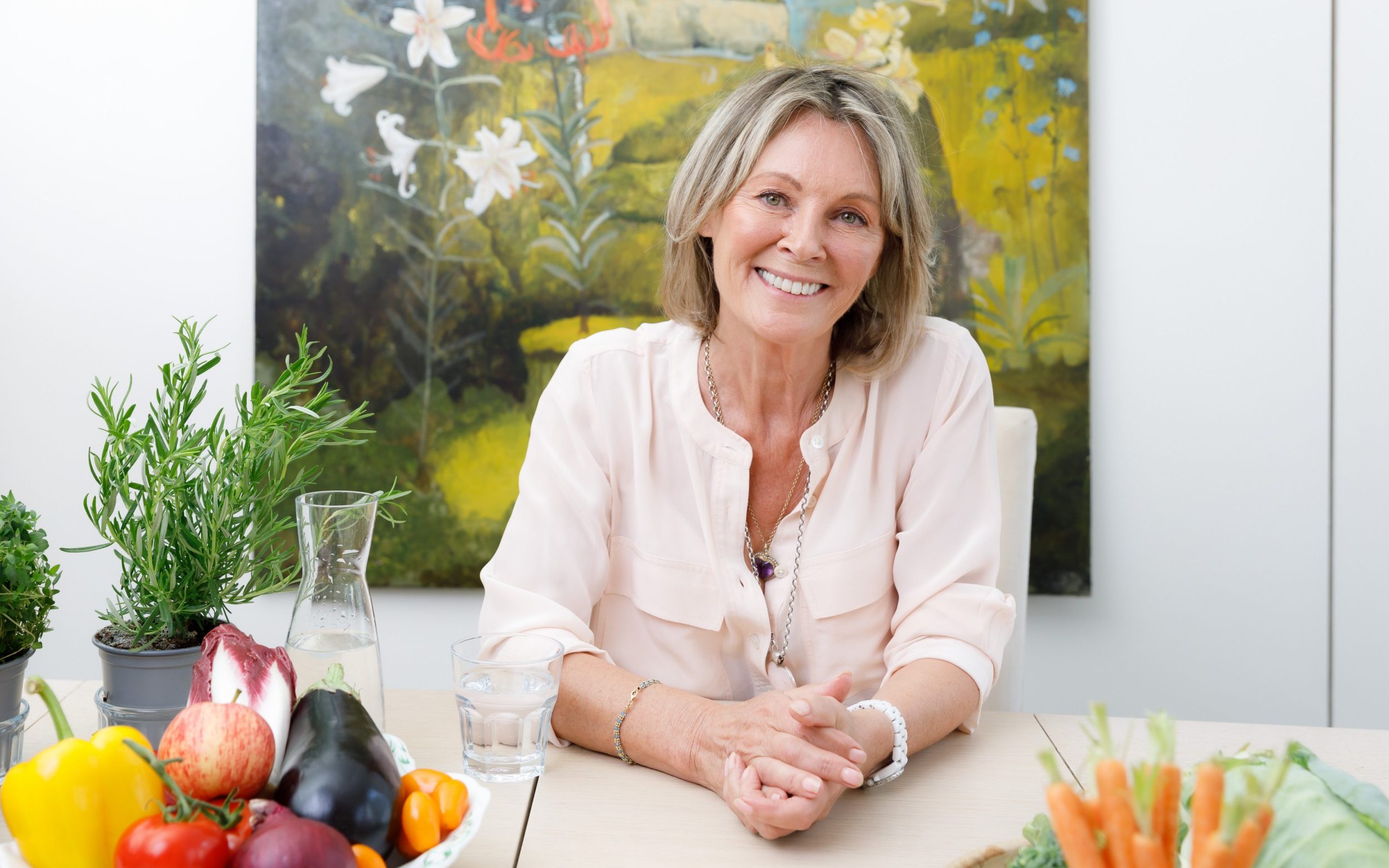
She admits she assumed they were making up the story. They're probably lounging on the sofa and snacking on chocolate.
It wasn't until she went through the menopause that she was able to say, "Thank goodness it happened to me. I'd been cutting down on my food portions and doing more exercise, yet I kept getting heavier and heavier."
The nutritionist had received her training at the Institute for Optimum Nutrition, but a course she undertook with the late Dr Wolf Funfack in 2008 was a turning point in her understanding of the body's nutritional requirements.
She thinks that restricting calories and doing high-intensity exercise can actually lower your metabolism, which is especially the case as we get older and our body composition changes. When she put on weight in middle age - increasing from 55 kg to 64 kg - she came up with a plan to get back to her original weight.
Now in her sixties, Ravenshear says: "I was very thankful for that lesson from my body." So too were her clients.
The success of her programme, achieving on average a weight loss of five to 14 pounds in just 16 days, was soon being talked about among friends. Enquiring friends would often ask those who had slimmed down how they'd managed it. Their response invariably was: "The Human Being Diet", also known as HBD.
Equipping people with the necessary means to instigate transformation in their own homes.
Jump to:
- What is this "Human Being Diet" you're referring to?
- Phase 1
- Phase 2
- Post-detox
- Phase 3
- Forever phase
- Meal plan and recipes
- FAQs
What is HBD?
You won't find any meal replacement bars or shakes available - shopping at your local supermarket for all your food is the norm.
“Weight Watchers and Slimming World are failing to educate people on the importance of consuming genuine wholesome food. This is about reconnecting with food that our bodies instinctively identify as nourishment.”
What types of food can I consume?
H.H. Dalai Lama's (HBD) diet is low in pulses and grains, and instead, it prioritises vegetables and high-quality protein like fish and eggs.
“Fats and proteins are the only truly essential food groups - carbohydrates are a secondary consideration,” says Ravenshear.
While vegetables are naturally low in calories, consuming an excessive amount of them won't necessarily lead to fat burning; it's because they're ultimately broken down into sugar.
When we consume something sugary, our body mistakenly identifies it as a threat and triggers the release of insulin. Insulin works diligently to remove the sugar from the bloodstream and send it into the cells, where it can be utilised to produce energy. “More often than not, it performs its function to an excessive degree. Consequently, our circulating blood glucose levels drop below the previous level. At this point, it can become nearly impossible to resist the urge for a sweet treat,” she explains.
“They're not considered vital, but they're actually crucial for feeling well."
However, Ravenshear's opinion is against eating whole grains. "People believe they're doing the right thing, but the wheat protein, a part of the gluten molecule, can pass through the blood-brain barrier. It then attaches to opioid receptors, which explains why wheat becomes addictive."
Pausing on whole wheat and grains at the beginning of the diet is recommended. This is because wheat is often connected to a condition known as a leaky gut, "which sets off the immune system and drains our energy" as partially undigested food makes its way into the bloodstream. Additionally, many people are also allergic to wheat.
As Ravenshear points out, quinoa essentially offers just a carbohydrate with positive publicity: “It centres around five times more carbohydrate than protein.”
It's worth noting that pulses are carbohydrates with a positive contribution of protein rather than traditional protein foods.
The 16-day detox
Embarking on an HBD journey is certainly not for the faint of heart. The initial 16-day period, known as The Reset, should ideally only commence once a year, though a maximum of two times a year is the exception. Expressions of interest to proceed should be restricted to those in the 18-year age bracket or above.
A thorough cleansing programme intended to break you down and create a fresh approach to life, HBD is not a traditional calorie counting diet, despite the fact that the initial 16 days involve a daily caloric intake of approximately 700-900 calories: "Though this has a beneficial impact on our microbes, which subsequently benefits us," Ravenshear explains.
Reducing calorie intake for extended periods can actually have a detrimental effect on your metabolic rate, however, research has found that in the short term, this type of diet can have anti-ageing benefits, as well as positive effects on blood pressure and life expectancy.
However, the initial 14-day period is the most challenging. "Typically, individuals who have read the book are very clear about their motivations," says Ravenshear. If your primary goal is weight loss, it is crucial to maintain commitment during the first 14 days, as this is when most weight is lost on the programme.
Phase One: Two days
"For the next two days, I plan on focusing my diet strictly on vegetables in order to nourish my gut and allow it to cleanse itself.
This means nothing that comes from oil is allowed, we'll keep calories low, no grains in sight, no dairy, no proteins from animal sources, no pulses like beans and lentils, and not a drop of alcohol. Some fruits like avocados and tomatoes are granted permission, whereas potatoes are off the menu.
If you experience persistent pain or have an autoimmune disorder, you may need to avoid additional nightshade vegetables, including peppers, tomatoes, and aubergines.
You'll be working alongside organic apple cider vinegar, salt, and pepper, along with fresh and fried herbs to produce your flavour combinations.
“Individuals frequently prepare large quantities of soup in advance during this time,” says Ravenshear.
Kicking sugar abruptly can lead to headaches: "It's not unusual for people to experience flu-like symptoms. Getting rid of all the rubbish and introducing fresh vegetables can be quite extreme."
Phase Two: 14 days
Now the food weighing-in starts. Again, nothing containing oil, alcohol, sugar, wheat, or grains is allowed. However, pulses, fruit, nuts, or seeds and other non-starchy protein foods are reintroduced into the diet.
A breakfast option would consist of 100g of a high-protein food, preferably with 100g of vitamins and fibre provided by vegetables. This could be either 100g of chicken, turkey breast minus the skin, or 100g of fresh salmon, alternatively a pair of eggs could also suffice. An alternative choice would be 35g of sunflower and pumpkin seeds, combined with a fresh apple grated to a pulp.
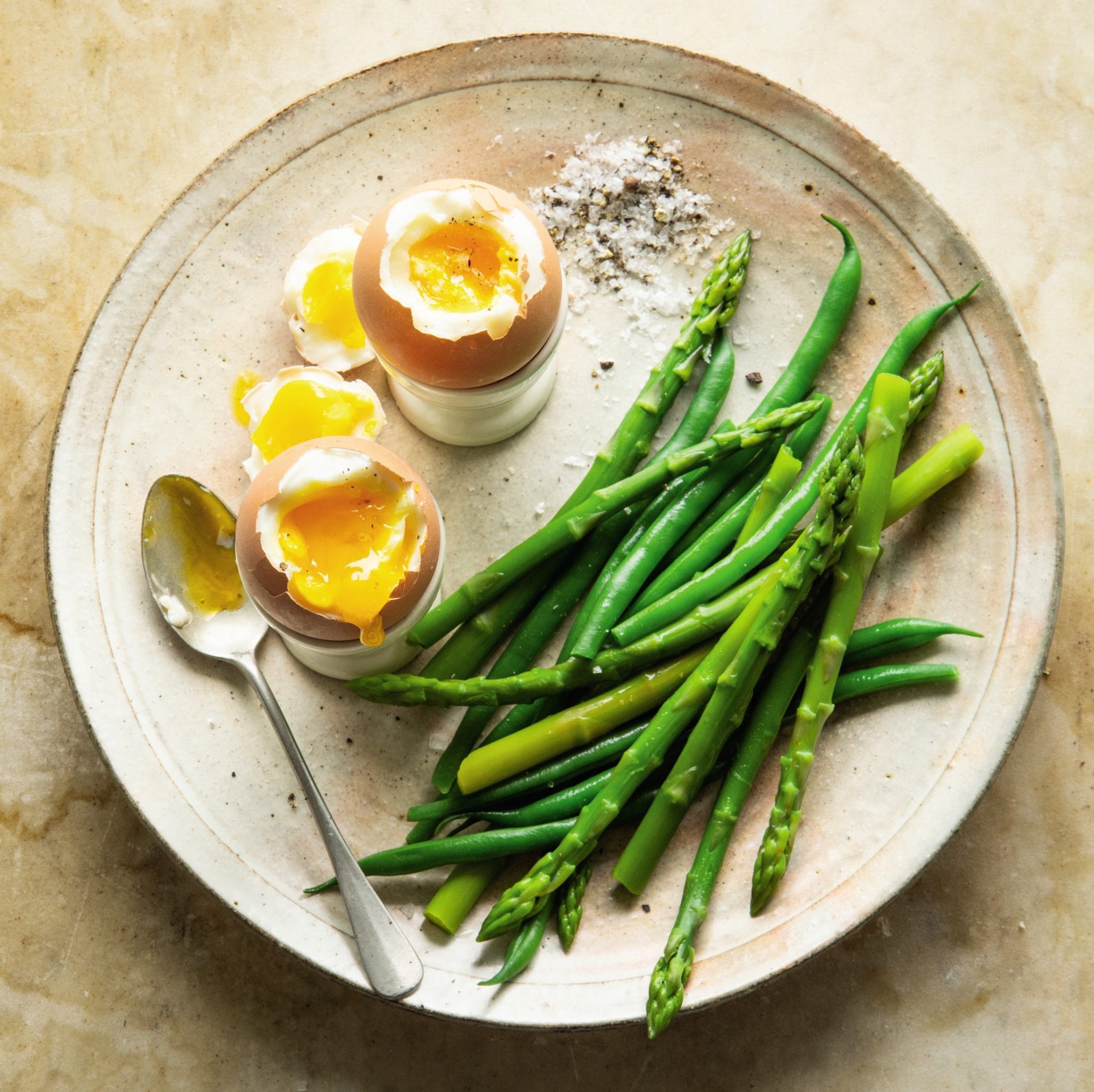
Please note, the information below is for guidance purposes only. For more tailored advice, we recommend consulting a healthcare professional. Assuming an average diet, meal recommendations are as follows:
For individuals weighing less than 65kg, a suitable lunch and dinner could include approximately 120g of protein and 120g of vegetables daily.
For those weighing between 65-80kg, slightly more protein may be beneficial, equating to around 130g each day.
For individuals with a body weight exceeding 80kg, an increase to 140g of protein per day could be advantageous.
This aims to lower insulin levels and provide the digestive system time to dispose of undigested food and fibre. You should only drink plain water in between; other liquids might interfere with our blood sugar levels.
According to Ravenshear, having breakfast is crucial as it helps to reset our body's internal clock and improves our sensitivity to leptin, a key hormone. He explains: "Leptin is one of the hormones that can drop out during the midlife phase. If we have insufficient leptin or our brain isn't responsive to it, we inevitably feel hungry all the time. Having breakfast in the morning counters that effect."
For now, it's a good idea to steer clear of dairy products as they often cause allergic reactions. We're especially looking for high protein foods, and milk, with its high water content, isn't a good fit, unlike richer dairy products like yogurt or cheese.
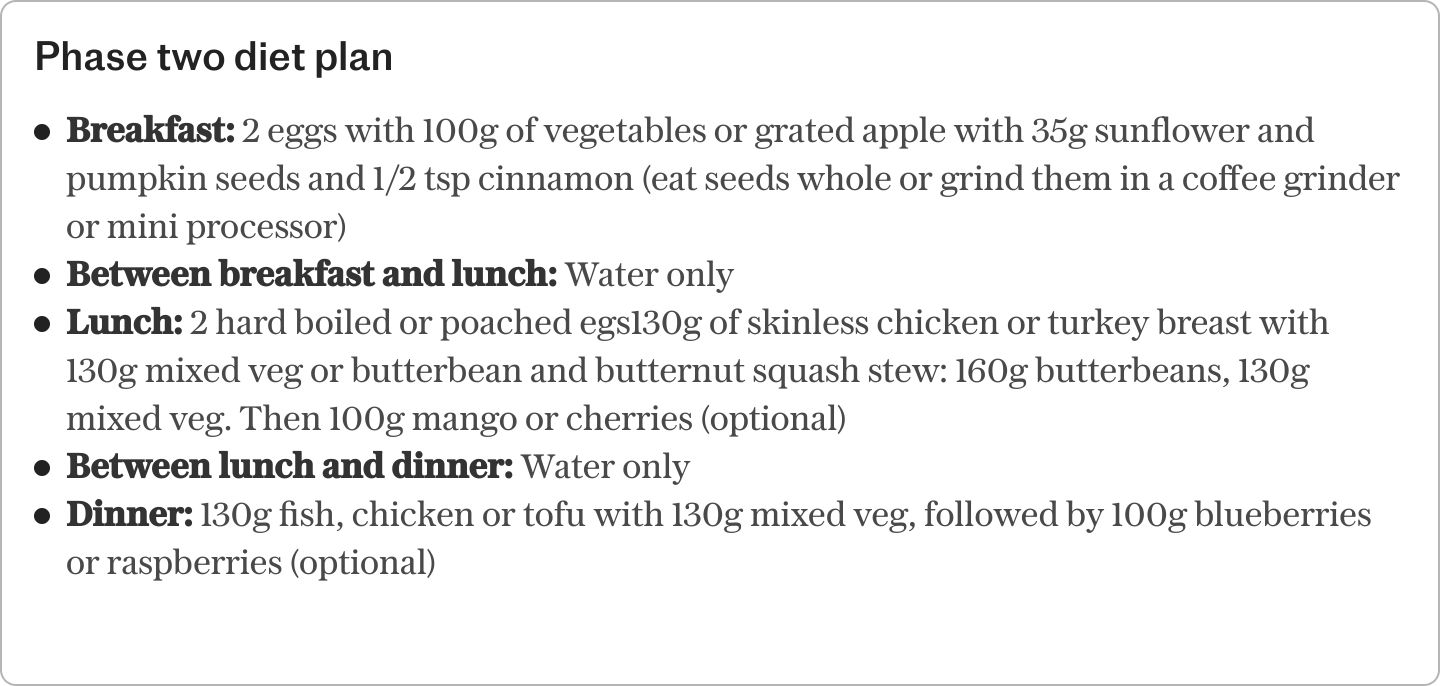
If you do choose to consume dairy, the advice is to opt for full-fat dairy products, such as those found in yogurt and cheese, as studies indicate that they can provide a greater feeling of fullness for longer. It's also recommended that you steer clear of processed cheeses, like cream cheese.
Ravenshear recommends that one type of protein should be consumed per meal. "If we mix different proteins, we may end up taking in fewer pure amino acids than if we had one type of protein on its own."
Scrambled(Egg)s are a prime source of protein because they contain an ideal combination of all essential amino acids in the right proportions for our bodies to build our internal proteins.
Protein not only aids in feeling full, but it also comprises an essential component of our bodily make-up. “It constructs our muscles, skin, hormones, and immune cells,” says Ravenshear. “Individuals who follow a plant-based diet often ask if they can follow the programme, and I let them know that it is unlikely to be effective unless they incorporate food sources such as tofu or tempeh.”
"Following each meal, you're permitted a piece of fruit, with one of these items being an apple at some point during the day," explains Ravenshear, a strong proponent of the benefits of fructose intake outweighing its drawbacks.
Post-detox
By Day 17, weight loss will be the body's most noticeable benefit from the detox.
It's worth noted, blood sugar levels may have normalised following HBD, which could mean you feel less peckish than you were beforehand and experience fewer cravings for food, even when eating smaller portions. “Others report improved energy and a more optimistic mood,” Ravenshear points out.
“They experience a decrease in inflammation right from the start, which means fewer aches and pains, some of which even disappear after just two weeks.”
In an emotional sense, individuals who follow the High Blood Pressure Diet (HBD) are more sensitive to their real emotions.
“Familiar hunger pangs signal a disconnection with our body's needs, and sometimes we turn to food out of boredom or as a source of comfort,” suggests Ravenshear.
There's also an appreciation for one's own strength. "It's a pretty considerable challenge for the first 16 days, and you might never think you possess the determination to see it through."
Phase Three: 10 weeks
In its entirety, HBD is a three-month course consisting of four phases.
Phase three is intended to last for 10 weeks. This period is when extra virgin olive oil is introduced. "It may not seem particularly enticing after 16 oil-free days, but it actually proves to be quite exciting. Participants can use it for cooking or add it to salads."
The most enjoyable aspect of stage three for high carb diets is that you can include a special treat meal once a week.
“On occasion, individuals experience discomfort after a specific meal, which can provide them with an indication of certain ingredients they would be better off avoiding, such as gluten, sugar, dairy, or alcohol.”
Hindu Hridaya Bedtime Routine (HBD) followers remain in Phase 3 until they are confident and pleased with their weight loss results, or for a maximum duration of 10 weeks.
The forever phase
At this point, a period of 10 weeks has passed, good habits should now be well-established.
At this stage, Health at Every Size (HAB-ers) have discovered which types of food they respond well to and which ones they should avoid. "And they stick with that," says Ravenshear. "It becomes a part of their daily routine."
It is what sets the HBD apart from other diets - "It's adopting a whole new lifestyle, with no endpoint in sight."
The #HBD community
There's undeniably a significant added value in the support and sense of belonging, which is a key factor in the diet's effectiveness. Presently, the Instagram community for #HBD is thriving. The hashtag serves as a means for those who follow the HBD to locate one another and, more importantly, support each other. "It's incredibly humbling. It's a really lovely safe space for individuals," says Ravenshear.
The community aspect is especially significant during the initial 16 days of HBD. Maintaining relationships with others on the journey adds a sense of accountability and fosters a sense of responsibility.
“I often find that having a tough day can make me browse social media, where I see things that motivate me to remember my core reasons for starting HBD. It helps me stay connected to why I embarked on this journey in the first place,” Ravenshear remarks. What initially led you to launch HBD? What specific aspects did you aim to alter?
It's a platform for discussing progress, with a special focus on achieving non-weight-related goals, because success is about far more than just weight loss.
One person, Clare, has successfully overcome chronic fatigue syndrome, also known as ME, and fibromyalgia, despite being told by doctors she would never walk again. "She's now, thanks to HBD, a dedicated runner and gym enthusiast," states Ravenshear.
Those who follow the HBD approach have noticed enhancements in various health issues, including Irritable Bowel Syndrome (IBS) and hormonal conditions like Polycystic Ovary Syndrome (PCOS) and menopause, as well as skin problems, depression, and general tiredness.
Dr. Mike Seddon, a consultant cardiologist, has gained support from the medical community. He, along with his wife and many of his colleagues, has adopted the HBD philosophy. "The Human Being Diet is built on strong and straightforward science combined with years of clinical experience," he says.
Meal plan and recipes
For the first phase, include fresh or dried herbs to add flavour and choose between fresh vegetables or chicken stock for your soup base. For day trips, it's obligatory to have an apple each day and added fruit is optional. In phase one, utilise fresh or dried herbs to flavour dishes and opt for fresh vegetables or chicken stock for soups or stir-fries.
You may enjoy unsweetened black tea and coffee with your food, but at other times, water is the preferred choice.
Recipes
From the H.B.D. Cookbook by Petronella Ravenshear:
1. Morning Pages - '"Morning pages is a self-invented journaling technique that involves writing three pages of unedited, hand-written thoughts and feelings in the morning, usually before getting out of bed".'
Spaghetti with butternut squash, curly kale, and small plum tomatoes
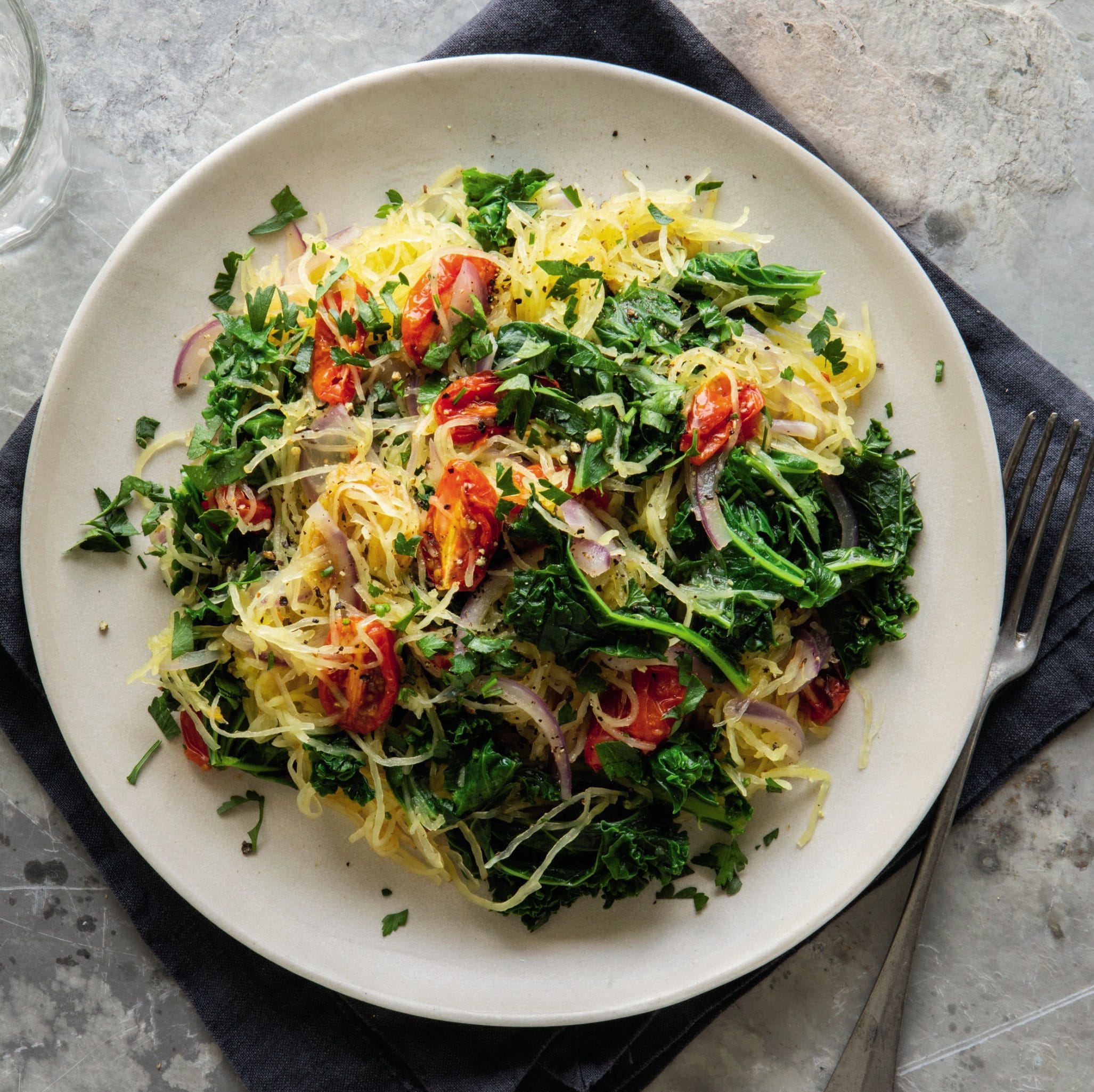
- 2
- 20 minutes
- 30 minutes
Ingredients
- 1 medium spaghetti squash, halved, and deseeded
- Pinch of ground cinnamon
- 100 grams of baby plum tomatoes, halved
- 1 big onion, finely chopped
- 2 garlic cloves, crushed
- A pinch of crushed, dried chilli pepper or red pepper flakes
- 75ml good-quality vegetable stock
- Approximately 200g of kale, trimmed and roughly chopped into large pieces.
- Rupees 1-3 mL of apple cider vinegar
- Small amounts of parsley, chopped into small pieces.
To serve
- Sea salt and powdered black pepper
Method
- Preheat your oven to 200 degrees Celsius or 180 degrees Celsius for a fan oven, and turn it onto gas mark 6. Place two baking trays lined with baking parchment in position.
- Lightly prick the squash skin with a fork. Sprinkle the inside of each squash half with cinnamon and season with a pinch of salt and pepper; place them cut-side down on a prepared baking tray. Arrange the tomatoes, cut-side facing upwards, on the other baking tray; season with a sprinkle of salt and pepper.
- Put the squash and tomatoes in the oven for 25-30 minutes or until the squash is cooked through but not overcooked and the tomatoes are beginning to turn brown. Take the squash and tomatoes out of the oven and once it has cooled down a bit, use a fork to remove the cooked squash strands.
- While that cooks, add the onion, garlic, chilli or red pepper flakes and 2 tablespoons of the vegetable stock to a frying pan over a medium heat, stirring occasionally every 6–8 minutes. Now stir in the kale with the remaining stock and let simmer gently for 3–4 minutes, until the kale has softened and the liquid is all soaked up. If the mixture seems too dry, give it a small spoonful of more stock to moisten it.
- Mix in the apple cider vinegar and fold in the courgette strands and tomatoes. Combine them gently.
- Divide the mixture between the two serving plates and sprinkle with the chopped parsley over the top.
A vibrant and lively aubergine and tomato curry
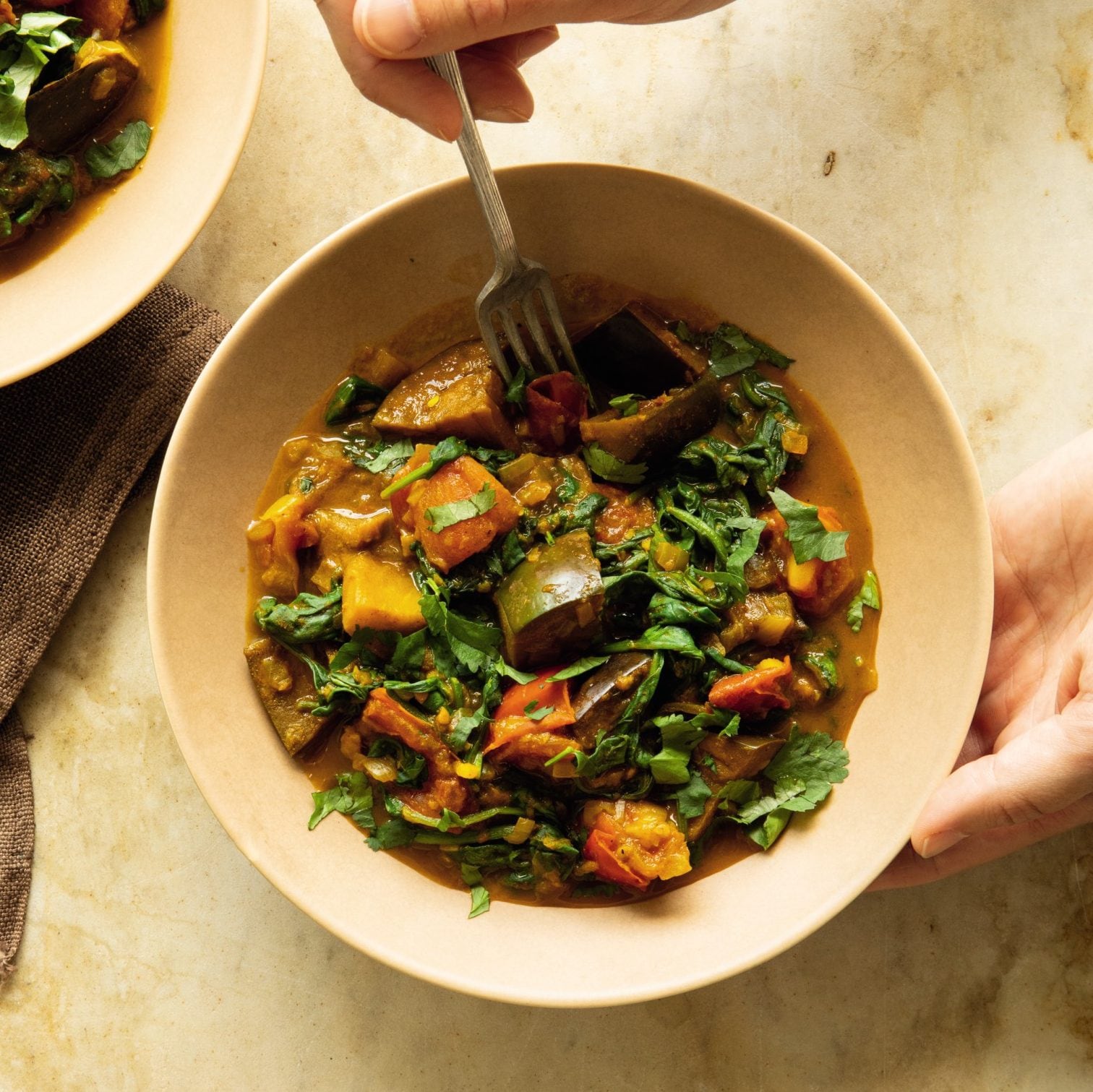
- 2
- 15 minutes
- 30-35 minutes
Ingredients
- 2 onions, chopped
- 3 garlic cloves, crushed
- Two and a half centimetres of fresh ginger, peeled and diced.
- 300ml good-quality vegetable stock
- 2 tsp ground turmeric
- 1 tsp ground cinnamon
- 1 tsp ground coriander
- ½ tsp ground cumin
- Three small tomatoes, cut either into quarters or bite-sized pieces.
- 1 medium-sized aubergine, trimmed and cut into small cubes
- Two hundred and fifty grams of fresh spinach leaves, washed, trimmed and shredded.
- Handful of coriander, chopped
- Sea salt and freshly ground black pepper.
Method
- Pop onions, garlic, ginger and stock into a big pan over a high heat. Put a lid on it, bring the stock to a rolling boil, and let it roll for 10 minutes. Once it's hot, reduce the heat to a simmer, take the lid off, and let it cook for a gentle 20 minutes, or until the onions are nice and tender, with a lovely golden colour.
- Mix in the ground spices and cook for approximately 3–4 minutes on a low to medium heat. Next, add the tomatoes and aubergine and stir gently from time to time until everything is tender. Make sure to regularly check the pan to prevent the aubergine from overcooking.
- About three minutes ahead of the cooking time coming to an end, add the spinach and cook until it has decayed and turned a beautiful shade of green. Season with salt and pepper as desired and stir in nearly all of the coriander.
- Split the curry between two individual plates and scatter the leftover coriander leaves on top.
Green shakshuka
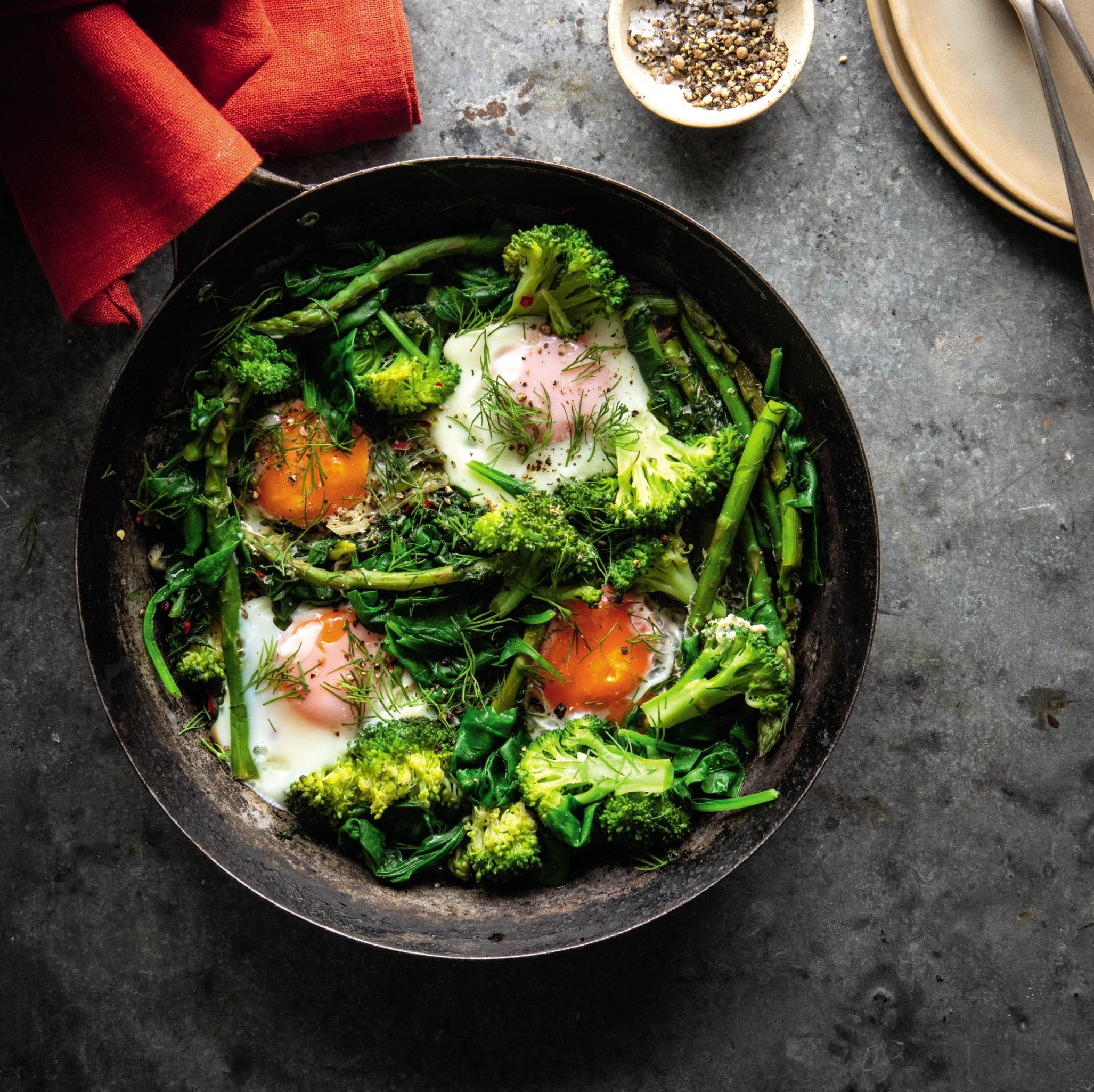
- 2
- 10 minutes
- 15 minutes
Ingredients
- 60ml good-quality vegetable stock
- 10 grams of spring onions, sliced thinly
- 1 garlic clove, crushed
- 1 red chilli*, diced
- Seventy-five grams of skinnified and halved asparagus spears.
- 75g broccoli florets
- Forty grams of spinach, trimmed and cut into smaller pieces.
- A small sprig of curly-leaf parsley or a small hand of dill
- 4 organic eggs
- Sea salt and freshly black pepper ground
Method
- Heat a large non-stick frying pan over a medium heat. Spoon in 1 tablespoon of vegetable stock and gently stir-fry the spring onion, garlic and chilli, stirring now and then, for 2–3 minutes or so until they're just tender. If the stock disappears rapidly, a touch more may be needed to stop the vegetables adhering to the pan.
- Meanwhile, briefly submerge the asparagus and broccoli florets in a pan of boiling water for two minutes. Drain carefully.
- Add the asparagus and broccoli to the frying pan and 'stir-fry' for 2 minutes until they're just starting to soften, still retaining a bit of crispness, adding more stock as required. Stir in the spinach and cook for 2 minutes until it's wilted and a vibrant green colour, then add the remaining stock. Continue cooking for 2–3 minutes to finish off the dish, adding the herbs in at the end. Finally, season with salt and pepper to taste.
- Gently press the back of a spoon into the top of the vegetable mixture, creating 4 small wells. Carefully crack an egg into each well, making sure not to break the yolk. Place a lid on the pan and cook over a low heat for approximately five minutes, or until the eggs are cooked through - the whites should be set and the yolks should still be slightly runny. Serve the dish hot.
Aegean fish stew
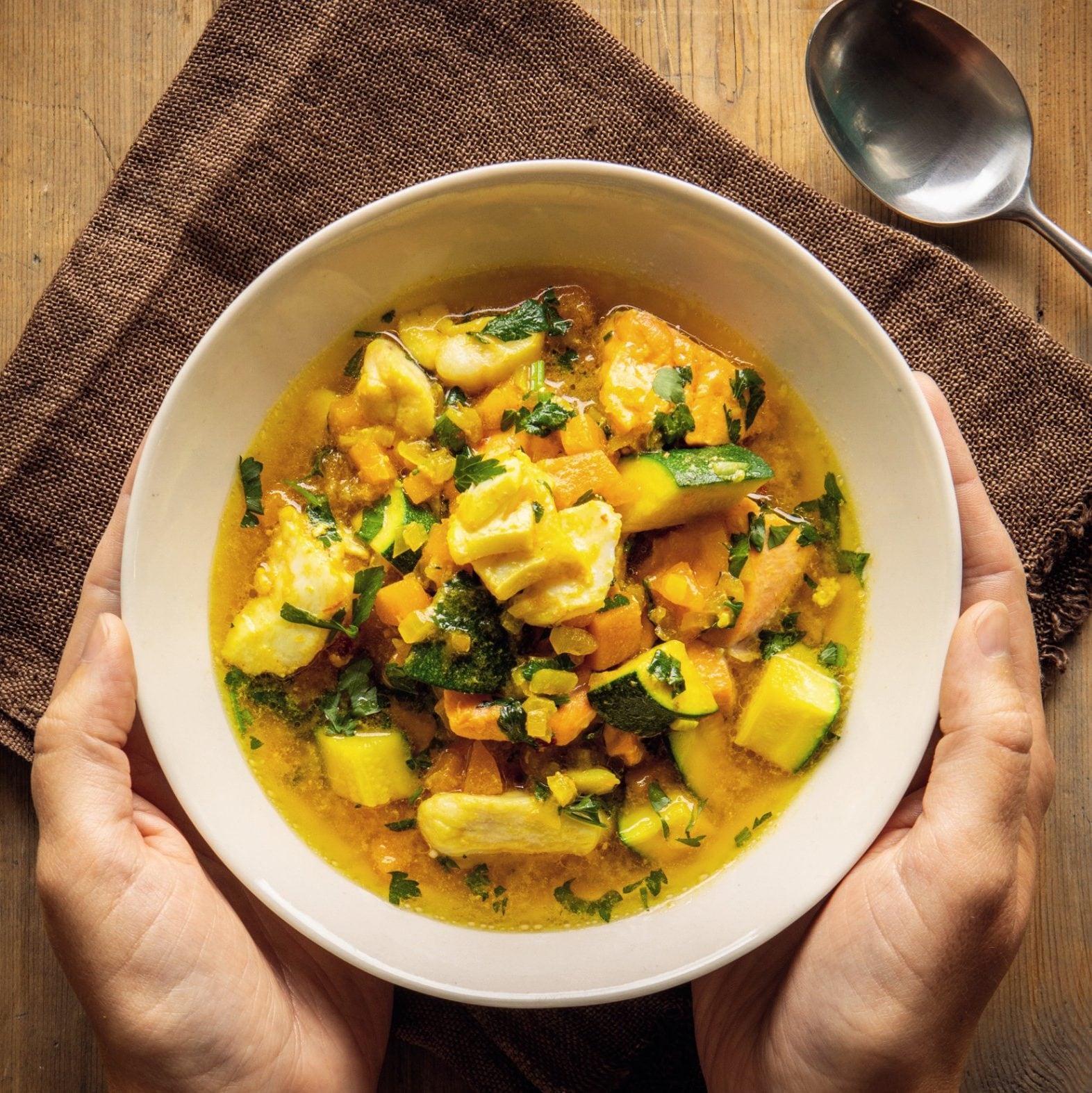
- 2
- 15 minutes
- 25-30 minutes
Ingredients
- Approximately 12fl oz of high-quality fish or vegetable stock
- 50g onion, diced
- One large butternut squash, approximately 160g in weight, peeled and cut into smaller cubes.
- 1 garlic clove, crushed
- 50g courgette, sliced
- A pinch of crushed dried red pepper flakes (optional)
- Pinch of saffron threads
- 1 bay leaf
- 260g mixed firm fish fillets (such as cod, sea bream, sea bass, red mullet, or salmon), cut into smaller chunks
- A small quantity of loose or leaf parsley, finely chopped.
- A pinch of sea salt and freshly ground black pepper
Method
- Place three tablespoons of stock into a large saucepan and put it on a moderate setting. Add in the onion, butternut squash and garlic, then cook for about 8–10 minutes, giving the mixture an occasional stir, until the ingredients have softened a bit. Just in case things start to dry up, you might need to add a bit more stock. Keep a close eye to ensure the ingredients don't develop a rich brown colour.
- Stir in the courgette, the chilli flakes (if using), and the saffron. Cook for a minute, then add the rest of the stock and the bay leaf.
- Bring the liquid to a boil, then lower the heat straight away to a minimum simmer and cover the pot. Let it cook slowly for 10 minutes, or until the vegetables are tender. Add the fish and let it simmer for another 5 minutes, or until it's just cooked and opaque. Taste the mixture and adjust the seasoning as needed with salt and pepper, then stir in the parsley.
- Divide the mixture between two shallow serving dishes, portioning the fish equally between them. Serve straight away.
Stir-fried ginger, chicken, and leafy greens
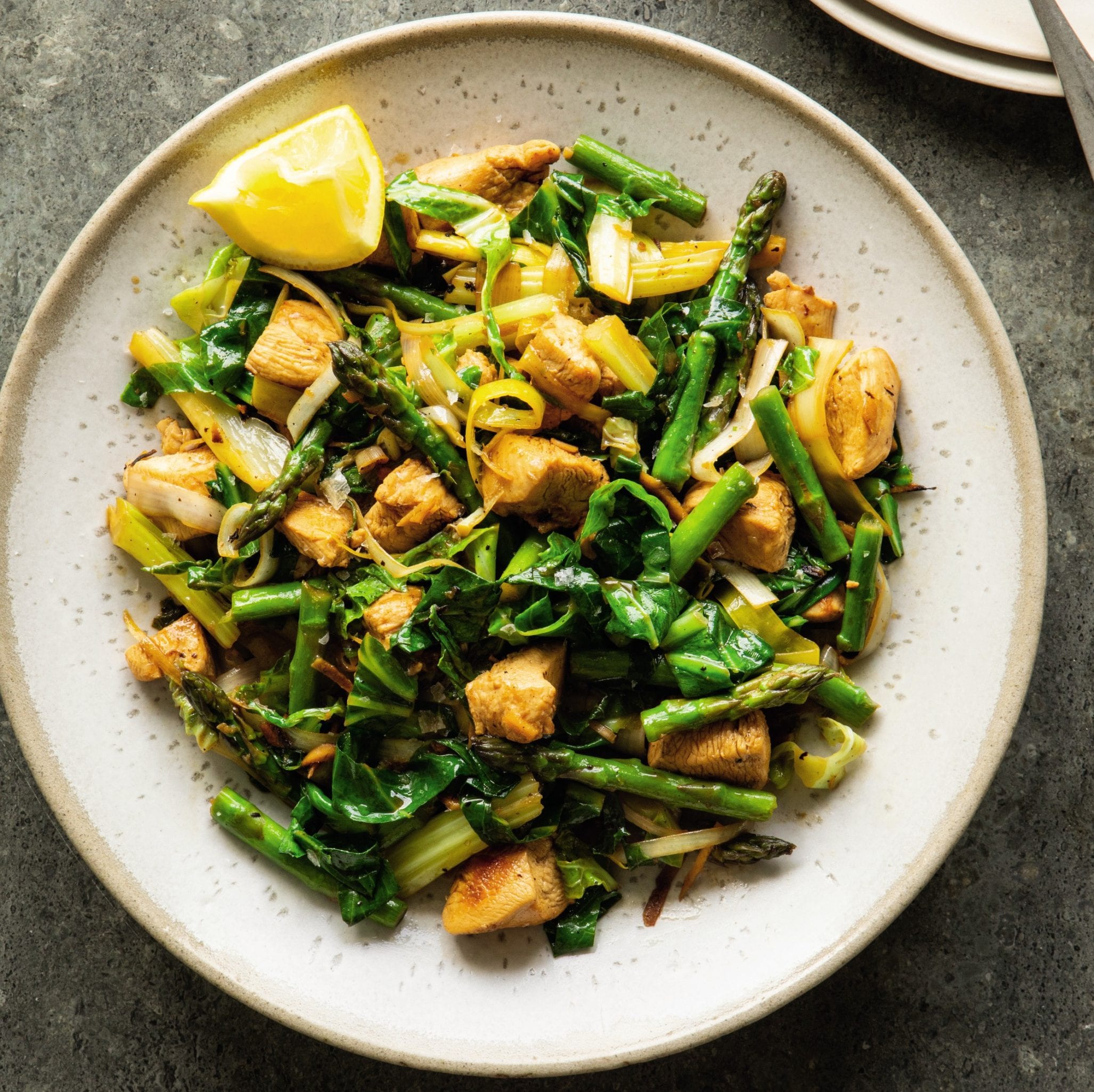
- 2
- 15 minutes
- 10 minutes
- 10-12 minutes
Ingredients
- 260g chicken breast fillets, boned and diced into small pieces
- A 2.5 centimetre piece of fresh ginger, peeled and roughly chopped into small pieces or shredded.
- 2 garlic cloves, crushed
- 1 lemongrass stalk, peeled and cut into thin slices
- 1 tbsp lemon juice
- 4-5 spoons of excellent vegetable stock
- Fifty grams of leeks, cleaned and chopped. Eighty-five grams of asparagus, trimmed and cut into bite-sized pieces.
- 25 grams of celery, cut into small sticks
- 100 grams of shredded spring greens or spinach leaves, thoroughly washed.
- Freshly ground black pepper and sea salt
Method
- Add the chicken pieces to a bowl along with the ginger, garlic, lemongrass and lemon juice. Mix them gently to coat the chicken, then place them in the refrigerator to marinate for 10 minutes.
- In the wok or frying pan, place two tablespoons of vegetable stock, and set the heat to medium to high. Now, add the chicken and stir-fry for around 4–5 minutes until it is cooked properly and nicely browned all over.
- Add the leeks, asparagus, celery and greens, and stir-fry for 4 to 5 minutes, with extra stock added as needed to keep the vegetables wet, until they are cooked and the asparagus and celery remain slightly crisp.
FAQ
I think there may be some confusion - it's actually the "human body" rather than "being" that you're asking about. Would you like to know if it's possible to exercise on a diet tailored to meet the nutritional needs of the human body?
Strenuous exercise is strictly off-limits. Not only are you not consuming sufficient nutrients to power your workouts, but the emphasis is on stimulating your parasympathetic nervous system, which aids in calming the body down.
“ Vigorous physical activity can be a stress trigger that leads to high cortisol levels. There is a significant connection between excessive midlife cortisol and weight gain, which is why many women find it challenging to lose weight in this stage of life”, says Petronella Ravenshear, the developer of this diet.''
Pilates or walking, alongside yoga, are all suitable options.
Can vegetarians follow a human diet?
Yes, it is possible for vegetarians to follow a balanced diet. Make certain to concentrate on high-quality protein sources such as tofu or organic tempeh.
What kind of weight loss can I expect on a human diet?
It's said that followers of the diet plan can expect to lose between five to 14 pounds over a period of 16 days. It's also worth noting, however, that there is no concrete scientific evidence to support these anecdotal claims, as no comprehensive studies have been conducted to assess the diet's effectiveness.
Recommended
Here is the paraphrased text:
The five-day rapid weight loss diet that reduces belly fat.
Read more
Enjoy Britain's top Puzzles from The Telegraph - and brighten up your day. Challenge your mind and lift your spirits with PlusWord, the Mini Crossword, the tricky Killer Sudoku and the classic Cryptic Crossword.
Post a Comment for "The 16-day diet that will help you lose half a stone"